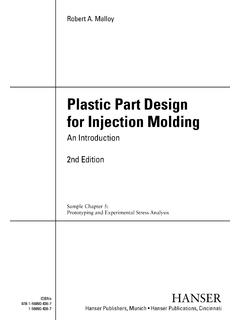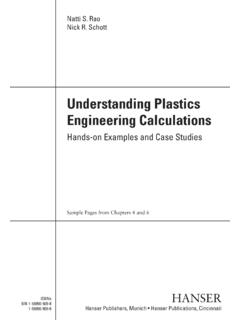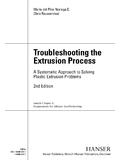Transcription of Chan I. Chung - hanserpublications.com
1 Extrusion of PolymersTheory & Practice 2nd EditionChan I. ChungISBNs978-1-56990-459-61-56990-459-6 HANSERH anser Publishers, Munich hanser publications , CincinnatiSample Chapter 2:Physical Description of Single-Screw Extrusion2 Physical Description of Single-Screw Functions of a Single-Screw ExtruderTh is chapter is intended to provide an overall physical understanding of the single-screw extrusion operation, including the relevant polymer properties and operating conditions. Although this chapter is quite lengthy, the reader will immediately become familiar with single-screw extrusion and develop further interests to study more details presented in the following chapters. Comprehension of the physical descriptions presented in this chapter alone may prove to be suffi ciently benefi cial for many readers, and help them to improve their processes and to Chapter 1; Fig.
2 , an extruder is used to melt a solid polymer and deliver the molten polymer for various forming or shaping processes. Th e screw is the only working component of the extruder. All other components (motor, gear-box, hopper, barrel and die, etc.) merely provide the necessary support for the screw to function properly. Th e overall functions of an extruder are depicted e feeding function of transferring the feed polymer from the hopper into the screw channel occurs outside of the screw, and it essentially does not depend on the screw design.+ 13+ 10:01 10:01:45142 Physical Description of Single-Screw ExtrusionTh e screw performs three basic functions: (1) solid conveying function, (2) melting function, and (3) metering function or pumping function.
3 Th e three screw functions occur simultaneously over most of the screw length and they are strongly interdependent. Th e geometric name of a screw section such as feeding section, shown in Chapter 1; Fig. , does not necessarily indicate the only function of the screw section. For example, the feeding section not only performs solid conveying function, but also melting and metering e screw also performs other secondary functions such as distributive mixing, dispersive mixing, and shear refi ning or homogenization. Distributive mixing refers to spacial rearrangement of diff erent components, and dispersive mixing refers to reduction of component sizes as described in Chapter 2; Section Shear refi ning refers to homogenization of polymer molecules by single-screw extruder is a continuous volumetric pump without back-mixing capability and without positive conveying capability.
4 What goes into a screw fi rst, comes out of the screw fi rst. A polymer, as solid or melt, moves down the screw channel by the forces exerted on the polymer by the rotating screw and the stationary barrel. Th ere is no mechanism to positively convey the polymer along the screw channel toward the die. Th e rotating screw grabs the polymer and tries to rotate the polymer with it. Suppose the barrel is removed from the extruder, or perfectly lubricated, such that it gives no resistance to the polymer movement. Th en the polymer simply rotates with the screw at the same speed and nothing comes out of the screw. Th e stationary barrel gives a breaking force to the rotating polymer and makes the polymer slip slightly on the screw surface.
5 Th e polymer still rotates with the screw rubbing on the barrel surface, but at a slightly lower speed than the screw, because of the slippage. Th e slippage of the polymer on the screw surface along the screw channel results in an output rate. A lubricated screw surface increases the output rate, but a lubricated barrel surface detrimentally reduces the output rate. It is clearly understandable why commercial screws are highly polished, and why grooved barrels in the feeding section are preferred. Although many commercial practices were developed empirically rather than based on theoretical analyses, they certainly agree with the underlying theoretical e mechanisms inside a single-screw extruder are studied by examining the polymer cross-sections along the screw channel taken from screw-freezing experiments.
6 In a screw-freezing experiment pioneered by Maddock [1], the screw is run to achieve a steady-state operation. Th en, the screw is stopped and water cooling is applied on the barrel (and also on the screw if possible) to freeze the polymer inside the screw channel. Th e barrel is heated again to melt the polymer, and the screw is pushed out of the barrel as the polymer starts to melt on the barrel surface. Th en, the solidifi ed polymer strip is removed from the screw channel and cut at many locations to examine the cross-sections along the screw channel. Some colored pellets are mixed in the feed to visualize the melting mechanism and the fl ow pattern. Th e colored pellets retain their shapes if they remained as solid inside the solid bed before the screw stopped, but they are + 14+ 10:01 10:01:4515 Overall Functions of a Single-Screw Extrudersheared and become streaks inside the melt pool if they were molten before the screw shows the cross-sections of acrylonitrile-butadiene-styrene copolymer (ABS) strip obtained from a screw-freezing experiment conducted at the Polymer Processing Technology Laboratory of the Dow Chemical Company USA.
7 Th e color version of Fig. is presented in Appendix A, and it shows the ABS cross-sections with better contrast. ABS pellets were extruded using a mm ( in) D, L/D = 21 conventional screw at 40 rpm. Th e three barrel zones from the hopper were set at 200, 230 and 250 C, respectively. Th e output rate was kg/hr (77 lbs/h) at 262 C melt temperature against MPa (1,100 psi) head Cross-sections of ABS strip along screw channel from screw-freezing experiment (courtesy of Mark Spalding, Kun S. Hyun, and Kevin Hughes, the Dow Chemical Co. USA) (color version is presented in Appendix A)+ 15+ 10:01 10:01:45162 Physical Description of Single-Screw ExtrusionTadmor and Klein [2], in their book, presented many examples of screw-freezing experiments.
8 Th eir Fig. for branched low density polyethylene (BLDPE) is reproduced in this book as Fig. BLDPE pellets were extruded using a mm ( ) D, L/D = 26 conventional screw at 80 RPM. All barrel zones were set at 232 C. Th e output rate was kg/h ( lbs/h) against MPa (1,650 psi) head to Figs. and , polymer pellets fed into a screw stay loose over the fi rst 2 4 L/D of the screw from the hopper until they are compacted. Loose pellets drop out of the screw when the screw is removed from the barrel. Th e pellets are quickly compacted over the next 2 3 L/D into a tightly packed solid bed . Th e solid bed moves down the screw channel as a rigid plug, and no mixing occurs inside the solid bed. Th e solid bed melts mainly by rubbing on the hot barrel surface as it rotates with the screw, and a thin melt fi lm is formed on the barrel surface.
9 Th e entire barrel immediately aft er the feed throat is set above the melting point of the polymer, unless an intensively water-cooled barrel section is used in the feeding section. Th e screw surface of the fi rst several L/D is continuously cooled by cold polymer feed in a steady-state operation. Th e rest of the screw also becomes hot above the melting point of the polymer because of the heat conducted from hot melt. A melt fi lm also is formed on hot screw surface, and the solid bed becomes surrounded by melt fi lm. Th e thin melt fi lm on the barrel surface is highly sheared by rotating solid bed, and a large amount of heat is generated within the thin melt fi lm. Th e thin melt fi lm is scraped off the barrel surface and collected into a melt pool by the advancing fl ight.
10 Th e melt pool is sheared and mixed as it is pumped or metered along the screw channel. Th e melt fi lm on the screw surface is sheared only slightly by the slow movement of the solid bed relative to the screw, and it is not scraped off the screw surface.+ 16+ 10:01 10:01:4617 Overall Functions of a Single-Screw ExtruderFigure Cross-sections of BLDPE strip along screw channel from screw-freezing experiment (reproduced from Tadmor and Klein [2])Th e solid bed width gradually decreases and the melt pool width increases as the solid bed melts along the screw, as shown in Fig. Melting of the solid bed is complete at about L/D = 15 in Fig. Th e solid bed melts primarily by the heat conducted from the thin melt fi lm on the barrel surface. Th e solid bed also melts on the hot screw surface and at the melt pool interface, but at a suffi ciently lower rate to be ignored in comparison to the melting rate on the barrel surface.









